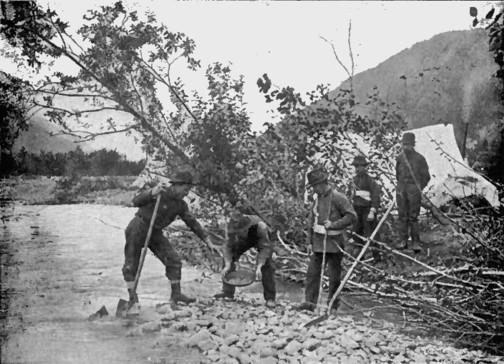The first post-office was erected by R. O. Adams. The business grew rapidly, and a larger building soon had to be provided, and about six hundred lock-boxes were put in the new building. At present a daily mail is received from each of the routes via Sidney, Cheyenne and Bismarck, and a weekly from Fort Pierre. About six hundred pounds of mail matter is brought in daily by these stages, and about eight thousand letters are received every twenty-four hours. Two hundred dollars' worth of stamps are sold daily; six hundred and fifty dollars' worth of money-orders issued, and about five hundred dollars' worth sent in registered letters daily. The amount of money orders issued in 1878 was one hundred and thirty five thousand nine hundred and seven dollars and fifty-seven cents. The cost of living in Deadwood is from eight to twelve dollars per week at the principal hotels or boarding-houses. Prices of provisions of all kinds are, of course, much higher than in the East, as the cost of freighting them over such long distances adds from four to six cents per pound to everything brought in. The average price of flour during 1879 was about eleven dollars per barrel; potatoes, one dollar per bushel ; eggs, forty cents per dozen ; bacon, sixteen to eighteen cents per pound ; hams, seventeen cents per pound ; pork, per barrel, thirty dollars ; corn, about one dollar and ninety cents per bushel, and oats about one dollar and forty cents per bushel, wholesale prices. Owing to the increase in home productions, produce is much cheaper than formerly.
Deadwood, unlike many mining towns, is at present a quiet, orderly city ; much of the wickedness and dissipation of the early days has disappeared. It seems to be a law-abiding community. It is true that in the early days murders and bloodshed were frequent. But the stranger who comes there now will hardly see a trace of such character at present.
Deadwood is erecting splendid water-works, and a thirty-two-mile canal, with two thousand feet of tunnels and several miles of iron piping, the whole costing something like one hundred and eighty thousand dollars. These things show the spirit of public improvement. This as well as other cities in the Black Hills has erected churches, schools and secret society buildings of various sorts. Merchants and others have settled here with their families, erected neat homes, and the place is not lacking for good, intelligent society. About two millions in gold dust have been taken from the placer mines in Deadwood Gulch alone. Single claims have reached a production of from fifty thousand to two hundred thousand dollars each. The largest gold nugget there found was worth one hundred and forty-seven dollars. Cottages rent from twenty-five to forty dollars per month ; business houses, twenty by forty feet, rent from one hundred to two hundred dollars per month, according to location. Real estate is correspondingly high, and city lots are up among the thousands. But titles to property in Deadwood are not very good the owners only having title by right of possession or "squatter's right," as the Government refuses to give a patent for the ground as a- town site, owing to the mineral character of the lands ; the laws forbid patents for town sites on ground proved to contain valuable deposits of gold ore. We insert in full the decision of the Commissioner of the General Land Office on this point, because it is valuable as being applicable to all town sites on mineral lands, and contains much of history in regard to the town-site controversy. It will be found in the Appendix.
DEPARTMENT OF THE
INTERIOR, GENERAL LAND OFFICE,
WASHINGTON, D. C, February 4th, 1880.
Register and Receiver, Deadwood, Dakota:
GENTLEMEN :
I have examined the record of testimony taken at the hearing I ordered by
letter from this office, dated April 10th, 1879, to determine the character
of the land embraced in the entry of the town site of Deadwood, made July
29th, 1879, by John R. Fraser, probate judge of Lawrence County, Dakota. At
the hearing, you held that the burden of proof devolved upon the mineral
claimants to establish the mineral character of the land. In making this
ruling you were in error. The said entry was made upon unsurveyed lands; the
lands were in a well-known Mineral Region; several mining claims had already
been entered and many more located. In short, it is well known, as a matter
of recent history, that the mineral character of the locality was the sole
incentive to the immigration which peopled the district, resulted in a
release of the same from the Sioux Indian reservation, and made necessary
the establishment of a United States Land Office in that place. No formal
withdrawal of the lands in question could have added force to the
presumption of their mineral character. They were upon unsurveyed land, and
hence no withdrawal could have given them a description by particular
designation, while the law itself reserved them, by their known character,
for conditional disposal only. It also may be added that, by no official act
or proceeding, was a presumption of their non-mineral character ever raised.
The presumption was that the lands were mineral, and the burden of proof,
therefore, was upon those who claimed to enter them as non-mineral lands.
By decision of this office, in case of the town site of Central City, Colorado, vs. Mineral Claimants, dated December 23d, 1875, and affirmed by the honorable Secretary of the Interior, June 6th, 1876, the mineral and town-site laws (section 2386, R. S.) were construed to permit town-site entries overlying Lode Claims. In this the two laws aforesaid are consistent, as a surface proprietorship by the town is compatible with an adverse ownership of veins of ore beneath; and the law seemed clearly to contemplate that condition of things, as will appear by reference to said section 2386, which limited its provisions to town proprietorship of the surface over veins. In placer-mining land, however, no fact is better established than that The Surface Is Essential to its development as mining ground. By decision of the honorable Secretary of the Interior, dated March 4th, 1879, in case of Kemp et al. vs. Stone, in Leadville, Colorado, it was declared the land being placer that as it was "valuable for minerals," it was not subject to entry as a town site, and that the testimony introduced to show that the land was more valuable for town purposes than mining was improperly received. If, therefore, the land embraced in the town site of Deadwood is valuable for placer mines, it there fore cannot be Patented to the trustee of the town, to be sold by him under local laws. The record of testimony consists of upward of eighteen hundred manuscript pages, a volume too great to be here discussed in detail. It has been carefully read, however, and the conclusion reached that no portion of the land entered as the, town site of Deadwood (which includes that of Ingleside) is proven to be non-mineral that is to say, that the presumed Mineral Character of the land has not been rebutted. I am further of the opinion that all of the land included within said town site, claimed for placer-mining purposes, respecting which testimony has been taken, has been conclusively shown by the testimony to be valuable for minerals, and hence must be held for disposal under the mining act, and patent cannot issue, therefore, for town-site purposes. I find from the testimony that several of these claims have yielded large quantities of gold.
Return
to The South Dakota Page:
South Dakota Gold Rush History



